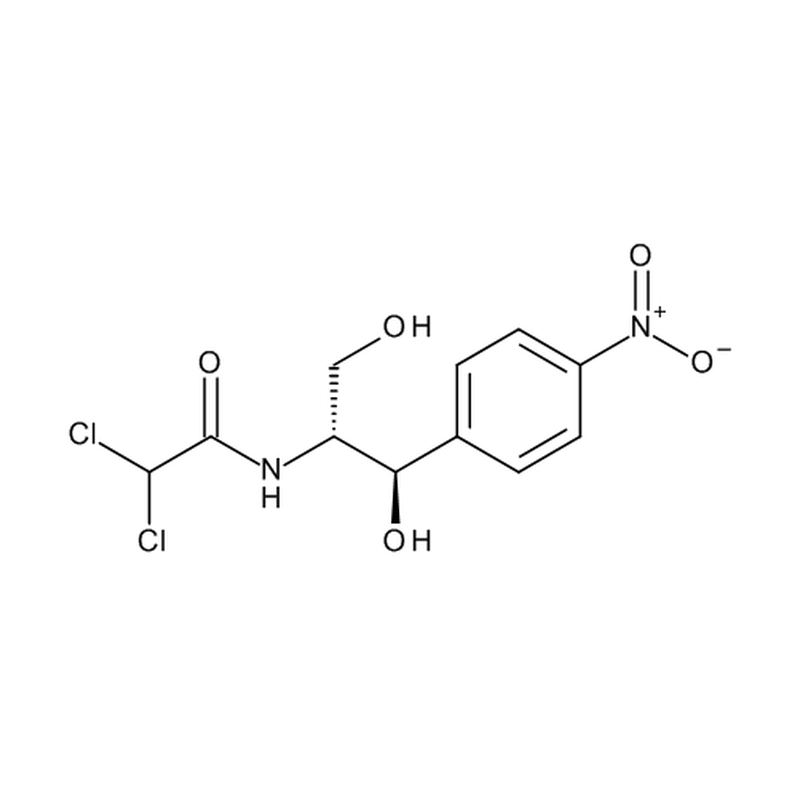产品
编 号:F392375
分子式:C11H12Cl2N2O5
分子量:323.13
分子式:C11H12Cl2N2O5
分子量:323.13
产品类型
规格
价格
是否有货
500mg
320
In-stock
1g
400
In-stock
5g
640
In-stock
结构图

CAS No: 56-75-7
产品详情
生物活性:
Chloramphenicol is an orally active, potent and broad-spectrum antibiotic. Chloramphenicol shows antibacterial activity. Chloramphenicol represses the oxygen-labile transcription factor and hypoxia inducible factor-1 alpha (HIF-1α) in hypoxic A549 and H1299 cells. Chloramphenicol suppresses the mRNA levels of vascular endothelial growth factor (VEGF) and glucose transporter 1, eventually decreasing VEGF release. Chloramphenicol can be used for anaerobic infections and lung cancer research.
体内研究:
Chloramphenicol (0-3500 mg/kg, Gavage, daily, for 5 days) decreases erythrocytes and erythrocyte precursors and reduces marrow erythroid cells were at day 1 post-dosing, and returns to normal by 14 days post-dosing.Animal Model:Female B6C3F1 mice (12-14 weeks old)
Dosage:0, 2500 and 3500 mg/kg
Administration:Gavage, daily, for 5 days
Result:Cessation of erythropoiesis was evident at day 1 post-dosing. A recovery was seen at day 7 post-dosing at the 2500 mg/kg dose level and at between 7 and 14 days at the 3500 mg/kg dose level. Myelotoxicity was most pronounced in the erythroid series at each dose level. Depressed femoral marrow BFU-E and CFU-E at day 1 post-dosing. All the blood and marrow parameters in the present study returned to normal by 14 days post-dosing.
体外研究:
Chloramphenicol (1-100 μg/mL, 18-24 h) inhibits the HIF-1α pathway in NSCLC cells in a concentration-dependent manner.Chloramphenicol (100 μg/mL, 0-24 h) induces autophagy in NSCLC cells, substantially increases the levels of autophagic biomarkers (beclin-1, Atg12-Atg5 conjugates, and LC3-II).Chloramphenicol induces abnormal differentiation and inhibits apoptosis in activated T cells.Chloramphenicol can inhibit both bacterial and mitochondrial protein synthesis, causing mitochondrial stress and decreased ATP biosynthesis.chloramphenicol (1-100 μg/mL) can induce matrix metalloproteinase (MMP)-13 expression and increase MMP-13 protein.chloramphenicol (1-100 μg/mL) can activate c-Jun N-terminal kinases (JNK) and phosphatidylinositol 3-kinase (PI-3K)/Akt signaling, leading to c-Jun protein phosphorylation.Chloramphenicol acts primarily on the 50S subunit of bacterial 70S rihosomes and inhibits peptide bond formation by suppressing peptidyl transferase activity.
Chloramphenicol is an orally active, potent and broad-spectrum antibiotic. Chloramphenicol shows antibacterial activity. Chloramphenicol represses the oxygen-labile transcription factor and hypoxia inducible factor-1 alpha (HIF-1α) in hypoxic A549 and H1299 cells. Chloramphenicol suppresses the mRNA levels of vascular endothelial growth factor (VEGF) and glucose transporter 1, eventually decreasing VEGF release. Chloramphenicol can be used for anaerobic infections and lung cancer research.
体内研究:
Chloramphenicol (0-3500 mg/kg, Gavage, daily, for 5 days) decreases erythrocytes and erythrocyte precursors and reduces marrow erythroid cells were at day 1 post-dosing, and returns to normal by 14 days post-dosing.Animal Model:Female B6C3F1 mice (12-14 weeks old)
Dosage:0, 2500 and 3500 mg/kg
Administration:Gavage, daily, for 5 days
Result:Cessation of erythropoiesis was evident at day 1 post-dosing. A recovery was seen at day 7 post-dosing at the 2500 mg/kg dose level and at between 7 and 14 days at the 3500 mg/kg dose level. Myelotoxicity was most pronounced in the erythroid series at each dose level. Depressed femoral marrow BFU-E and CFU-E at day 1 post-dosing. All the blood and marrow parameters in the present study returned to normal by 14 days post-dosing.
体外研究:
Chloramphenicol (1-100 μg/mL, 18-24 h) inhibits the HIF-1α pathway in NSCLC cells in a concentration-dependent manner.Chloramphenicol (100 μg/mL, 0-24 h) induces autophagy in NSCLC cells, substantially increases the levels of autophagic biomarkers (beclin-1, Atg12-Atg5 conjugates, and LC3-II).Chloramphenicol induces abnormal differentiation and inhibits apoptosis in activated T cells.Chloramphenicol can inhibit both bacterial and mitochondrial protein synthesis, causing mitochondrial stress and decreased ATP biosynthesis.chloramphenicol (1-100 μg/mL) can induce matrix metalloproteinase (MMP)-13 expression and increase MMP-13 protein.chloramphenicol (1-100 μg/mL) can activate c-Jun N-terminal kinases (JNK) and phosphatidylinositol 3-kinase (PI-3K)/Akt signaling, leading to c-Jun protein phosphorylation.Chloramphenicol acts primarily on the 50S subunit of bacterial 70S rihosomes and inhibits peptide bond formation by suppressing peptidyl transferase activity.
产品资料

